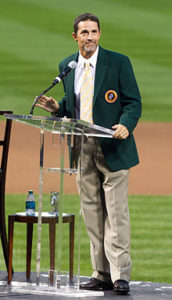Will Mussina enter the Hall of Fame as an Oriole?
When a player is immortalized in the baseball Hall-of-Fame, it’s because a decision was made to vote them in. For retired players, the Baseball Writers Association of America are behind those votes.
No matter how many total ballots are cast, a player has to be listed on 75% of them to qualify for Cooperstown. If a player receives more than 5% of votes but less than 75%, they’re eligible to remain on the ballot for ten years. After the tenth year, their name is removed.
In the case of former Baltimore Orioles starter Mike Mussina, his election into the baseball Hall-of-Fame came in his sixth year of eligibility, receiving 76.7% of all votes.
As has been discussed all over the baseball world, last night, Mariano Rivera, Edgar Martinez, the late Roy Halladay and the aforementioned Mussina, were announced as the class of 2019. Four individuals that played the game with passion and made impacts for their respective teams.
Although Rivera and Martínez spent their entire careers with one team, Halladay and Mussina spent multiple years with different teams.
Halladay, killed in a plane crash on November 7, 2017, spent 12 years north of the border with the Toronto Blue Jays before being traded to the Philadelphia Phillies. He pitched four seasons there.
Mussina pitched ten years for the Orioles from 1991-2000. He was signed as a free agent by the New York Yankees, where he went on to pitch from 2001 until his retirement after the end of the 2008 season.
You’d think, on his plaque to hang forever in Cooperstown, a player would want to represent the team he played for the longest. It should be an easy choice for him to make. The only problem with that sentiment is, it’s not up to him.
It’s not fully his decision
Although a player can influence the decision, it’s ultimately up to the Hall-of-Fame to finalize which cap is enshrined on their plaque. In an interview in 2009, Hall-of-Fame president Jeff Idelson explained to ESPN why this decision was made:
“From our standpoint, the logo isn’t something we want to be controversial, because the last thing you want is to have a divisive factor when someone’s being celebrated with baseball’s greatest honor. And for any player who played for multiple teams, the fans in each of those cities should claim that player to be their own. Because without that player’s time with that team, he arguably would not have been a Hall of Famer. But we try to decide where the player made his most indelible mark.”
Just a handful of players have gone into the hall without a team being represented. Greg Maddux, inducted in 2014 and Tony La Russa are examples of inductees that do not represent a team on their plaque. Maddux pitched for 11 seasons in Atlanta and 10 with the Cubs in Chicago. La Russa managed the Chicago White Sox, but won World Series championships with the Oakland Athletics and St. Louis Cardinals.
In regards to how much of a factor the player has in the decision making process, Idelson told ESPN:
“If a player’s career is very evenly divided, we’ll give more leeway to him.”
And that’s just the problem with Mike Mussina. His career wasn’t necessarily as evenly defined as we think.
Should he recommend the Orioles
For Mussina, one would argue that his career was more defined with the Baltimore Orioles. As mentioned last night in the official Orioles press release:
A five-time American League All-Star (all with Baltimore), Mussina won seven Gold Gloves, including four with the Orioles, and finished inside the top six of Cy Young Award voting nine times, seven with Baltimore. As a member of the Orioles, Mussina led the American League with a .783 winning percentage (18-5) in 1992; wins (19); shutouts (four); and walks per 9.0 innings (2.03) in 1995; games started (36) in 1996; and innings pitched (237.2) in 2000. He tossed three one-hitters with the Orioles and struck out 15 batters in a game twice. In six career postseason starts with the Orioles, Mussina went 2-1 with a 2.53 ERA (12 ER/42.2 IP). He was inducted into the Orioles Hall of Fame in 2012.
Although Mussina spent ten seasons with the Orioles, five of those years the team lost more than they won. Keep in mind the strike-shortened years of 1994 and 1995 are included in that total.
His fifth-and-final All-Star nod came in 1999. While the team finished fourth in the AL East with a 78-and-84 record, Mussina was busy leading starters in ERA (3.50), wins (18), strikeouts (172) and WHIP (1.274). He also finished second to Pedro Martinez for the AL Cy Young that season.
On the flip side, Mussina did have a run of seven straight seasons appearing in the postseason with the Yankees. While never losing more than 11 games in pinstripes, he did post some of his higher ERAs in his final eight seasons. In 2004 and 2005, he posted back-to-back ERAs higher than 4.40 and a 5.15 – his highest of any season – in 2007. He quickly followed that with a 20-win season in what was his final season in the majors.
It’ll be a difficult decision for Mussina to influence. When asked what hat will be on his head, he replied:
“I can’t choose. I mean, to play ten seasons in one place and eight seasons in the other and have pretty comfortable numbers in both places, I wouldn’t be on this phone call if it wasn’t for both places. You can’t say one did it over the other. I started my career in one place, had a lot of success, and I finished my career in the other place and had a lot of success. I played for both organizations, I’m proud to have played for both organizations, but there’s no way I could pick one over the other.”
Mussina said he’d have an answer on what cap he’d like to wear by July. But judging by the comments last night, I think we may already have our answer.






